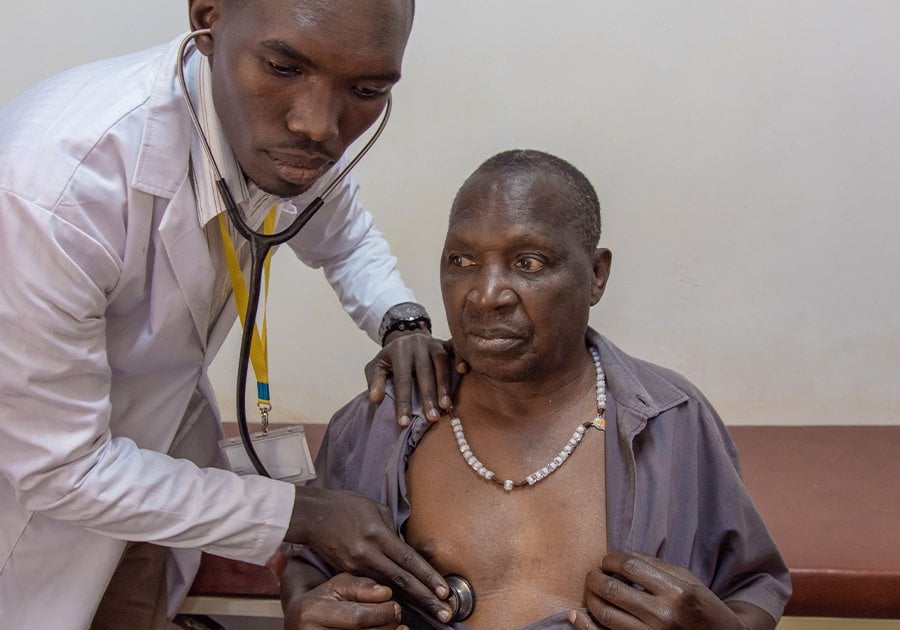
Scientists of the Global Cardiovascular Risk Consortium have proven that the five classic cardiovascular risk factors, that is, overweight, high blood pressure, high cholesterol, smoking, and diabetes mellitus are directly connected to more than half of all cardiovascular diseases worldwide. The study also found that these risk factors account for nearly a third of deaths in sub-Saharan Africa. High blood pressure is the most significant factor for the occurrence of heart attacks and strokes. The study’s results were published in the New England Journal of Medicine and are based on the data of 1.5 million persons from 34 countries, including The Gambia.
Cardiovascular diseases cause approximately a third of all deaths worldwide. They often develop silently over decades. Frequently without being recognised, the vascular walls change and become hardened or thickened, in the wake of which coronary heart disease may occur, including complications such as heart attacks, acute cardiac death, or strokes.
The Global Cardiovascular Risk Consortium assessed the individual-level data of 1.5 million persons who took part in 112 cohort studies and originate from the eight geographical regions North America, Latin America, Western Europe, Eastern Europe and Russia, North Africa and the Middle East, Sub-Saharan Africa, Asia, and Australia. The objective of the study was to gain a better understanding of the global distribution, the significance of the individual risk factors and their effects on cardiovascular diseases, and overall mortality in order to derive targeted preventive measures.
The study showed differences in the eight global regions regarding the frequency of the risk factors. The scientists saw the highest rates for overweight in Latin America, and the highest values for high blood pressure and high cholesterol in Europe. The risk factor smoking is particularly decisive in Latin America and Eastern Europe, diabetes mellitus in North Africa and in the Middle East. All five risk factors combined (overweight, high blood pressure, high cholesterol, smoking, and diabetes mellitus) amount to 57.2 per cent of women’s cardiovascular risk and to 52.6 per cent of men’s. Thus, a substantial share of cardiovascular risk remains unexplained. In comparison, the five risk factors merely account for about 20 per cent of the risk to die (overall mortality). This is substantially higher in sub-Saharan Africa where the five modifiable risk factors account for deaths in 30.8 per cent in women and 33.5 per cent in men. “This is a huge proportion compared to high-income settings given the already high burden of communicable diseases the region is still faced with. We will therefore prevent a lot of deaths in the region if these five modifiable risk factors, which are responsive to preventive measures, are controlled” says co-author Dr Modou Jobe, a Clinical Research Fellow at the MRC Unit The Gambia and a member of the Global Cardiovascular Risk Consortium Management Group.
Furthermore, the study also clearly shows a linear relation between high blood pressure, and high cholesterol, and the occurrence of cardiovascular diseases. The higher the values, the higher the likelihood of the occurrence of cardiovascular diseases. This result applies to all examined regions in the world. The scientists also identified a remarkable connection between cholesterol levels and overall mortality: Very low as well as high cholesterol levels increase overall mortality. Compared to other regions, the study could not assess cardiovascular disease incidence in sub-Saharan Africa due to lack of data. “This should motivate academic institutions and funders to ensure that more data on cardiovascular disease incidence are collected and in a reliable way” says Professor Andrew Prentice, Head of the Nutrition and Planetary Health Theme at the MRC Unit The Gambia at LSHTM and one of the authors.
The significance of all risk factors decreases with age. For example, high blood pressure is more damaging to a forty than an eighty-year-old. The body mass index (BMI) is the only exception and remains equally significant at any age. “This has important implications for treatment approaches in different age groups and raises further questions as to whether treatment targets for elderly and younger populations should be revisited,” says Professor Prentice.
The study provides an extensive dataset to avoid cardiovascular diseases or reduce their effects for at-risk persons, or patients with cardiovascular diseases, by improving their lifestyle and by lowering blood pressure or cholesterol. “Concerted efforts to reduce these modifiable risk factors are necessary to reduce cardiovascular diseases and deaths as much as possible” says Dr Jobe.
Our postgraduate taught courses provide health practitioners, clinicians, policy-makers, scientists and recent graduates with a world-class qualification in public and global health.
If you are coming to LSHTM to study a distance learning programme (PG Cert, PG Dip, MSc or individual modules) starting in 2024, you may be eligible for a 5% discount on your tuition fees.
These fee reduction schemes are available for a limited time only.
